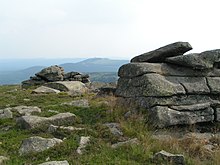Block heaps of the Brockens

The block heaps of the Brocken are ice-age weathering formations of the Brocken granite , which arose under periglacial climatic conditions. The block heaps in the Brocken area were designated a National Geotope in 2006.
Formation of the block heaps on the Brocken
In the Cretaceous and Tertiary periods , the Harz was lifted out in the course of mountain-building processes . Under the subtropical climatic conditions prevailing at the time , the rocks of the Brocken massif were deeply weathered and the granites were exposed on the surface. The weathering came mainly from the dividing surfaces. The granites in the area of the Brockenplutons are characterized by a pronounced orthogonal fracture system . The result of weathering was the partial decomposition of the Brocken granite to grus . In the course of the earth's history, the grus was washed out and the remaining granite rocks with rounded edges partially collapsed, while other granite cliffs were used as rock mountains, e.g. B. the Ottofels , the Feuersteinklippe or the hop sacks remained. During the Ice Age summer periods, the ground thawed near the surface and slid down the slope due to gravity together with individual granite blocks, forming so-called block heaps at the slope and foot of the slope . Harzer block heaps, which can be found outside the distribution area of the Brocken granite, can be traced back to a different genesis. The block heaps from Hornfels , Harzburger Gabbro or Eckergneis were created by frost blasting during the last Ice Age. In contrast to the rounded granite blocks, the boulders in these block heaps are angular.
The block heaps in the area of the Brocken Pluton are at least approx. 10,000 years old.
Vegetation, worthy of protection
The largely substrateless, arid scree slopes are characterized by a characteristic microclimate . A dry, warm climate is widespread on the rock surface, while the inside of the heap is relatively balanced. The cavities in the heaps have their own air circulation system. While the warm air is sucked in at the top of the pile in summer and flows through the depth of the pile and cools down to such an extent that it exits significantly cooler at the bottom of the pile, the flow conditions are reversed in winter, so that the warmer air from inside the pile in the direction of Haldenkopf rises.
As a result of the extreme temperature conditions with strong fluctuations, only plant and animal species that have been adapted to these conditions can spread in the area of the block heaps - especially lichens , mosses and some dwarf shrubs. Lizards and fire salamanders are quite common in the log heaps . Some bats, such as the northern bat, use the dumps as day quarters.
Due to the rare plant and animal communities, the block heaps are habitats that are highly worthy of protection and are generally not allowed to be entered.
Individual evidence
- ↑ a b c Manfred Frühauf , Katja Hagen: With Goethe and Heine around the Brocken - The Harzer Blockhalden . In: Ernst-Rüdiger Look, HeraLudger Feldmann (Ed.): Fascination Geology. The important geotopes of Germany . E. Schweizerbart'sche Verlagsbuchhandlung, Stuttgart 2007, ISBN 978-3-510-65221-1 , p. 40 f .
- ↑ Friedhart Knolle , Béatrice Oesterreich, Rainer Schulz and Volker Wrede: The resin . Geological excursions. In: Perthes excursion guide . Justus Perthes, Gotha 1997, ISBN 3-623-00659-9 , pp. 130-144 .
- ↑ Harz National Park. Block heaps - seas of stone. Retrieved July 7, 2013 .
Web links
- Harz National Park: Block heaps - Seas of Stone , accessed on July 8, 2013
